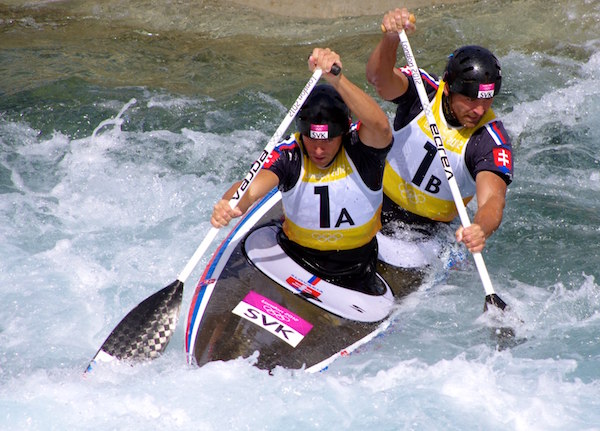All About Canoe/Kayak
When you or I think of canoeing, we probably think of the classic ponderous green painted boat and arguments between the person in the back and the person in the front over who is pulling harder and why can’t the person steering do a better job. For kayaking, we might thing of overly fit middle-aged people who put us to shame. Olympic canoe/kayak is a completely different animal. These are streamlined boats that skim over the water at breakneck speed, driven by powerful athletes who rarely, if ever, argue about who is pulling harder.
How Does Canoe/Kayak Work?
There are two different types of boats and two different types of races. The two boat types are canoes and kayaks. In recreational use, these are very different looking boats. In their Olympic racing forms, you’d be forgiven for not being able to tell the difference. The key visual difference to my eyes is one that is true of recreational boating — kayakers use double bladed paddles and stroke on both sides while canoe racers have a single bladed paddle. Racing kayaks also have rudders controlled by foot pedals. The two kinds of races are sprints, which are straight ahead races judged only by speed, and slalom races which require competitors to navigate white-water rapids while weaving between preset gates. In slalom races, the time an athlete takes to complete the course may be modified by time penalties for hitting or missing gates entirely.
Why do People Like Watching Canoe/Kayak?
Despite the large differences between sprint and slalom races and between canoe and kayak forms, the general attraction is the same. The thrill of watching Olympic Canoeing is in seeing powerful athletes who seem to be in perfect sync with their crafts. I find paddling an awkward, unnatural motion, but in the hands of a broad chested, granite shouldered Olympian, it looks completely natural. Sprinters at their peak pace are fluid to the point of being uncanny, like a poorly done CGI monster that doesn’t seem to have enough weight in its movement.
Check out some highlights from the 2012 Olympics:
What are the different events?
Within the sprint category of races, events are separated by distance, gender, and number of people in each boat. The range is from 200 meters to 1,000 meters and from one person in a boat to four. Within slalom, there are only three events — one person and two person canoes, and one person kayaks. Each slalom event is on the same course, although gates may be placed in different places.
How Dangerous is Canoe/Kayak?
While boating down rapids can be very dangerous in real life, here, in a controlled environment, with world-class athletes wearing helmets, there’s very little threat of real injury. The sprints, meanwhile, are even safer.
What’s the State of Gender Equality in Canoe/Kayak?
Piss poor. In slalom, women only get to compete in one person kayaks, while men do that plus one and two person canoes. In sprinting, the men have eight events to the women’s four, including shorter and longer sprints in kayaks (women seem to only get medium distances). Looking at this again, it becomes clear that women do not compete in any canoeing events, only kayak ones. Someone please explain why women shouldn’t be allowed to canoe??!
Links!
Bookmark the full Olympics schedule from NBC. Canoe/Kayak is from Sunday, August 7 to Saturday, August 20.
Read more about canoe/kayak on the official Rio Olympics site. Here’s the page on slalom and the one on sprint,

